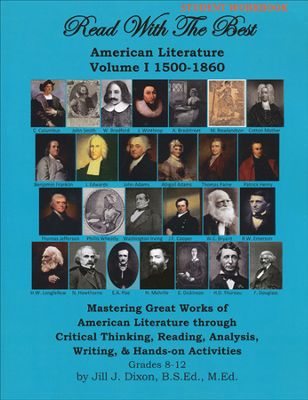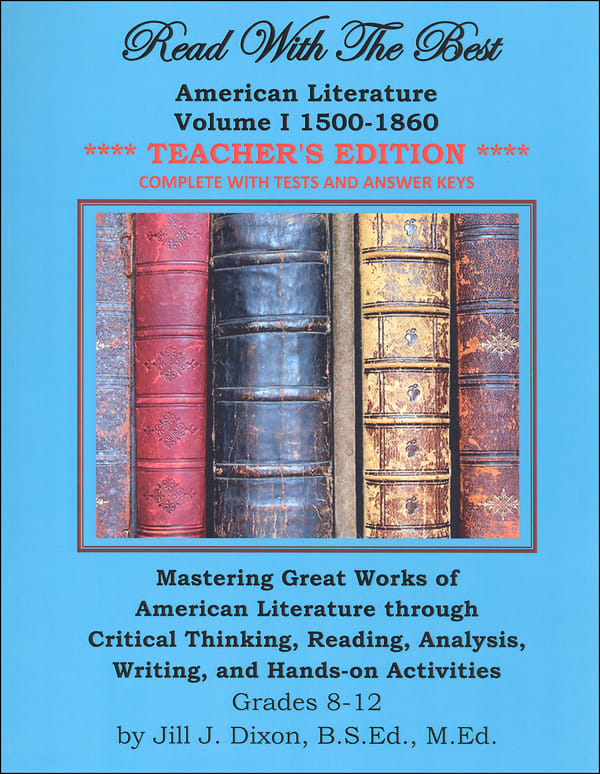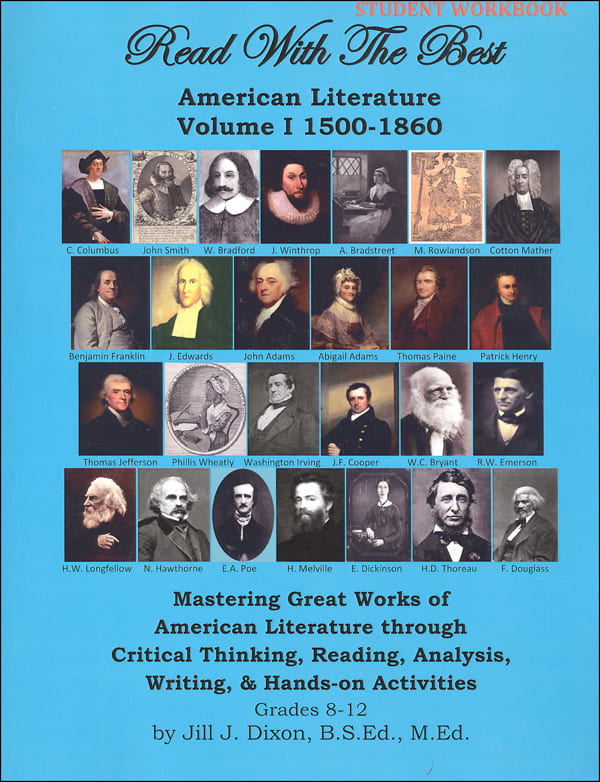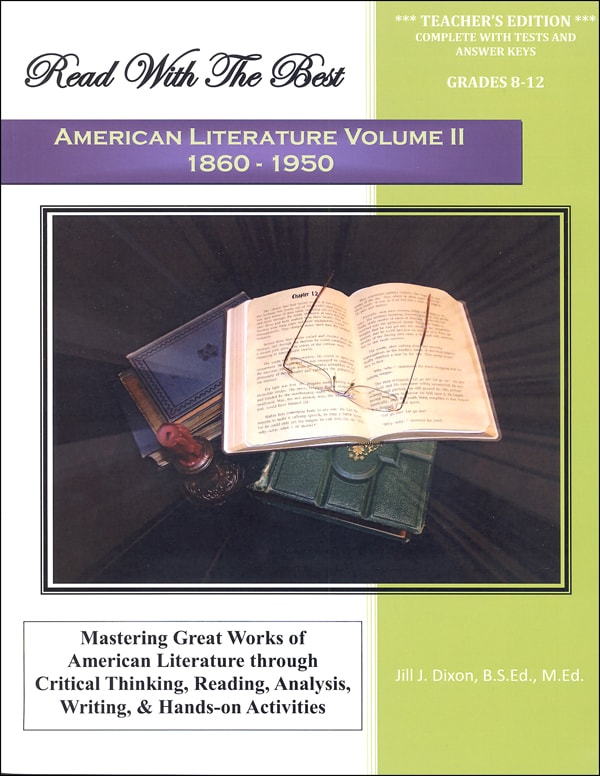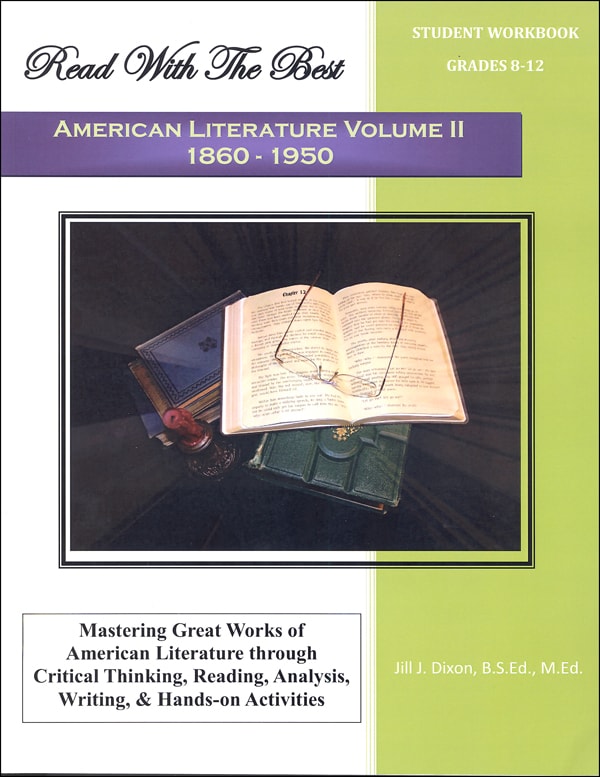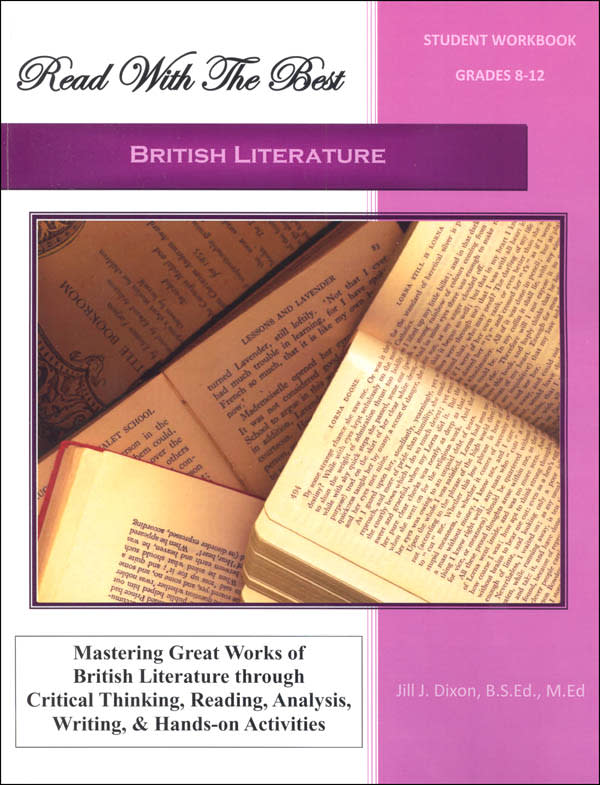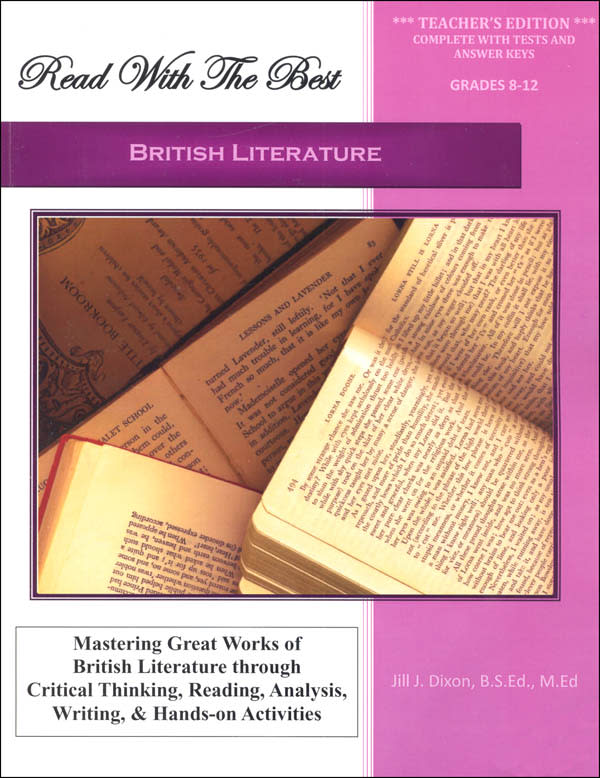Jill Dixon has been teaching group classes to homeschoolers for years. Her Read With the Best literature courses are her newest publications. Thus far, Jill has written Read With the Best American Literature: Volume I 1500-1860,Read With the Best American LiteratureVolume II 1860-1950 and Read With the Best British Literature. Each volume is a one year course. While these courses are ideal for co-op style classes for grades nine through eleven, some eighth graders might be ready for this level of work as well. Courses are not only for advanced, college-prep students. Dixon offers suggestions for students with learning difficulties such as accessing free audio readings of classic works from www.librivox.org.
Students completing these courses should be well prepared for the ACT and SAT exams as well as for college credit exams such as CLEP and AP. For example, a student who has completed the two-year study of American Literature should be equipped to take and pass the AP English Literature and AP English Language and Composition exams as well as the CLEP American Literature exam.
Read with the Best courses are worth multiple credits each year. Students completing each course should earn 1 credit in literature and 1 credit in composition. They might also earn up to ¼ credit in U.S. History upon completion of each study of American Literature. Clearly, this is more than your average high school language arts course. Some students might need additional work on grammar or on vocabulary skills for the SAT or ACT, so Dixon lists some of her recommended resources for both topics.
American Literature Volume I serves as an introduction to literary and critical analysis, so students should begin with that course, and follow in sequence with American Literature Volume II, British Literature, and World Literature. (World Literature should be available in 2017.)
You will need additional resources for all courses. Many of the same resources are used in both American Literature courses, and all courses require Writing a Research Paper: A Step-By-Step Approach (Sadlier-Oxford Publishing) and Write With the Best, Volume 2 (another resource by Jill Dixon).
Other resources used with both American Literature courses are The Norton Anthology of American Literature, Shorter Seventh Edition and The New American Heritage Dictionary and Thesaurus. For Volume I you will also need the Kaplan SAT version of The Scarlet Letter, and for Volume II you will need The Red Badge of Courage, The Autobiography of an Ex-Colored Man, The Crucible, and Our Town.
For British Literature, students will use The Norton Anthology of English Literature: The Major Authors, eighth edition, Macbeth (No Fear Shakespeare by Spark Publishing), Frankenstein, The Screwtape Letters, and one or two novels of their choice.
Students will read the complete literary works required for each course as well as selected readings from each The Norton Anthology. Dixon says, “The literature in Read With the Best of American Literature was chosen for its literary, moral, analytic and didactic or inspirational quality. The works and authors are also works and authors that any student who desires an adequate education should be familiar with” (p. vi). She also notes that many of the selected works are also listed in the AP English literature and CLEP American Literature guides. Similarly, the same standards were used in selection of British literary works.
Weekly lessons are laid out so that students work through them step by step working independently for the most part. Each week's lessons include five or six different components, with some components appearing more than once. Students can write responses for questions and vocabulary work directly in their student workbooks, but they will probably write lengthier essays and papers on a computer.
Lessons begin with a “Background Check,” a series of questions about the background of the featured author drawing on biographical information included in the Norton Anthology. If more than one author’s work is studied that week, there will be an additional Background Check on the other author.
Vocabulary study is the focus of “Words to Know” exercises. For each group of words, students have a chart to fill in identifying the part of speech and listing one or two synonyms. Students also learn literary analysis terms related to the literary passage each week. They are quizzed separately on vocabulary words (every four weeks) and literary terms (every six weeks).
Students answer a series of “Critical Reading” questions for each literary work. These questions get into critical analysis and often require critical thinking skills although some simpler comprehension questions are included. British Literature includes a very helpful “Fiction Literature Guide” in the appendix of the student workbook—seven pages of questions to help students analyze works of fiction. You will want to make copies of these pages for students to use with each book they read.
“Make it Real” assignments help students make a connection from what they are learning to the present or otherwise think divergently about what they have learned. For example, the lesson on The Autobiography of Benjamin Franklin says, “Try to come up with your own aphorism such as Franklin wrote in Poor Richard’s Almanac” (Volume I, p. 71).
Writing assignments gradually develop students’ writing skills, with lessons frequently directing students to Write with the Best, Volume 2 for skill development and directions that they will then apply to the literary work they are studying. While students write each week, they will be completing a composition assignment every two weeks. Twelve weeks of the second semester are dedicated to work on a research paper.
A “Culminating Activity” concludes each week’s lesson. These vary from week to week, but they might involve such things as dramatic reading, creative writing, drawing, and discussion. Dixon used Culminating Activities when co-op classes met each week, so most are designed with a group in mind. Most everything else in these courses can be done independently, but some Culminating Activities won’t make sense without a group. That doesn’t make the curriculum unusable for a solitary student, but it eliminates some enjoyable activities. Co-op class time should also be used for discussing the readings, sharing written work, and taking quizzes and tests.
The publisher describes Dixon’s books as “fluff-free products,” by which they mean that there’s hardly anything in these books that isn’t part of the course work. The courses are very easy to use. The course requirements, procedures, and test schedules are clearly explained on six pages at the beginning of each course. Everything is laid out in the order to be followed, and students studying independently can easily understand what to do next. At the beginning of each book, the table of contents and weekly schedule are combined into one with check-off boxes included so students can easily track completion of each assignment.
Read With the Best courses are secular, but they emphasize positive character traits and morality. So while they do not have religious content, they support Judeo-Christian values.
The courses offer more variety and interesting activities than do most other high school literature courses, especially those that would be considered AP level courses. While these courses can be used for independent study, I highly recommend trying to use them within co-op classes that meet once a week both for student motivation and because many of the shared exercises add a great deal to the enjoyment of the courses.




